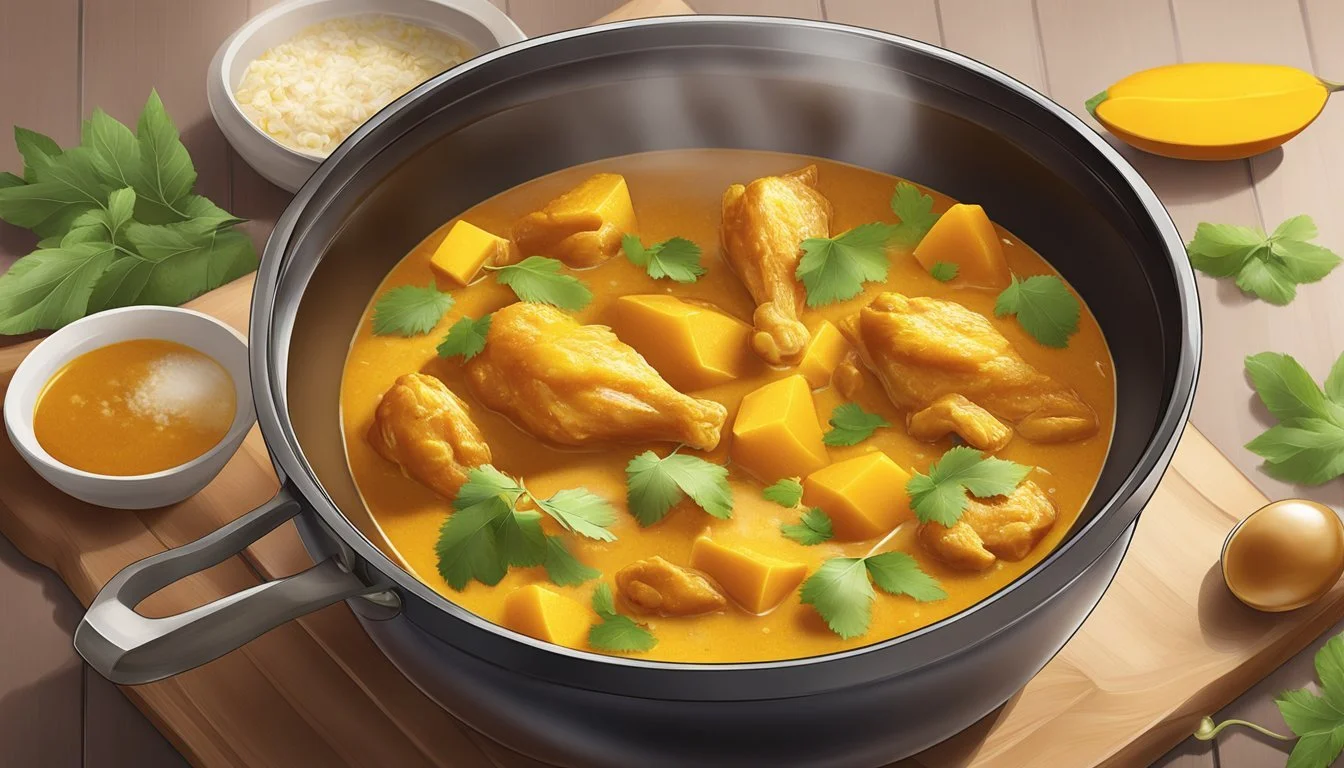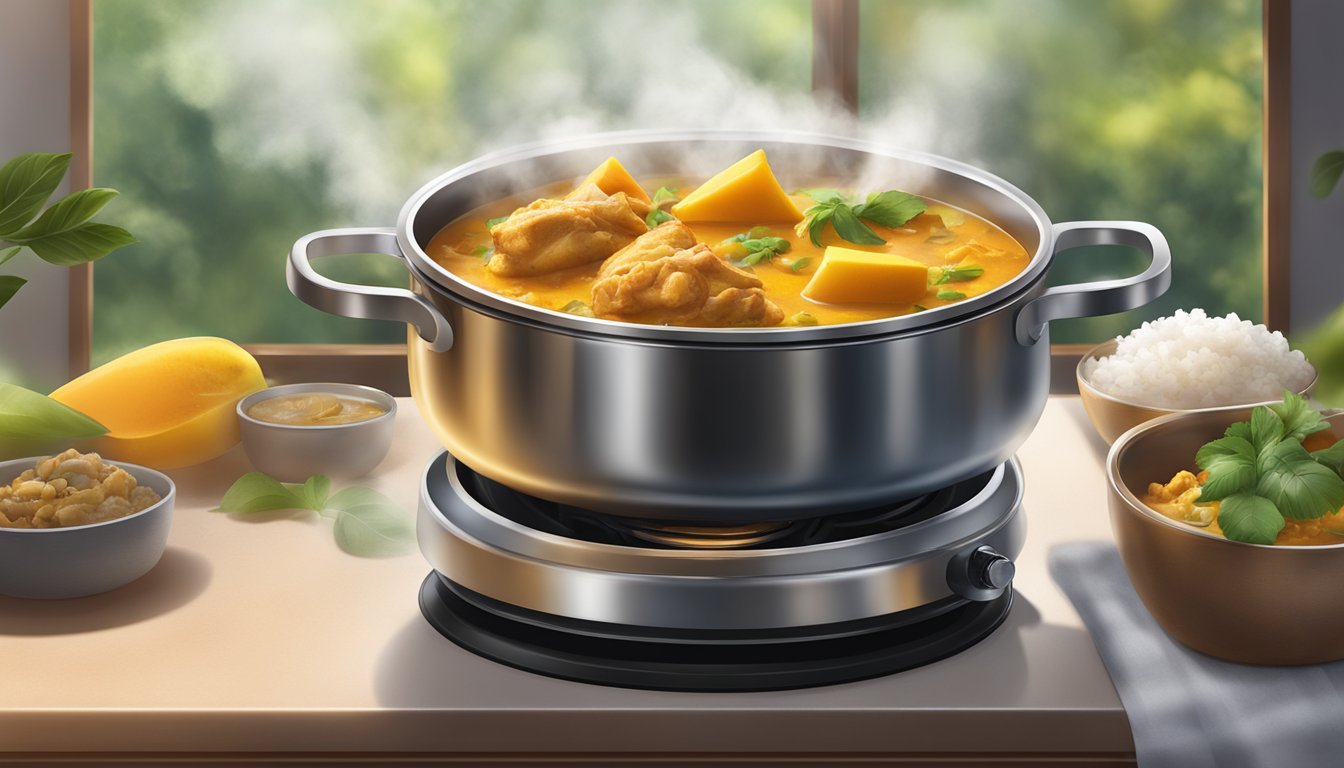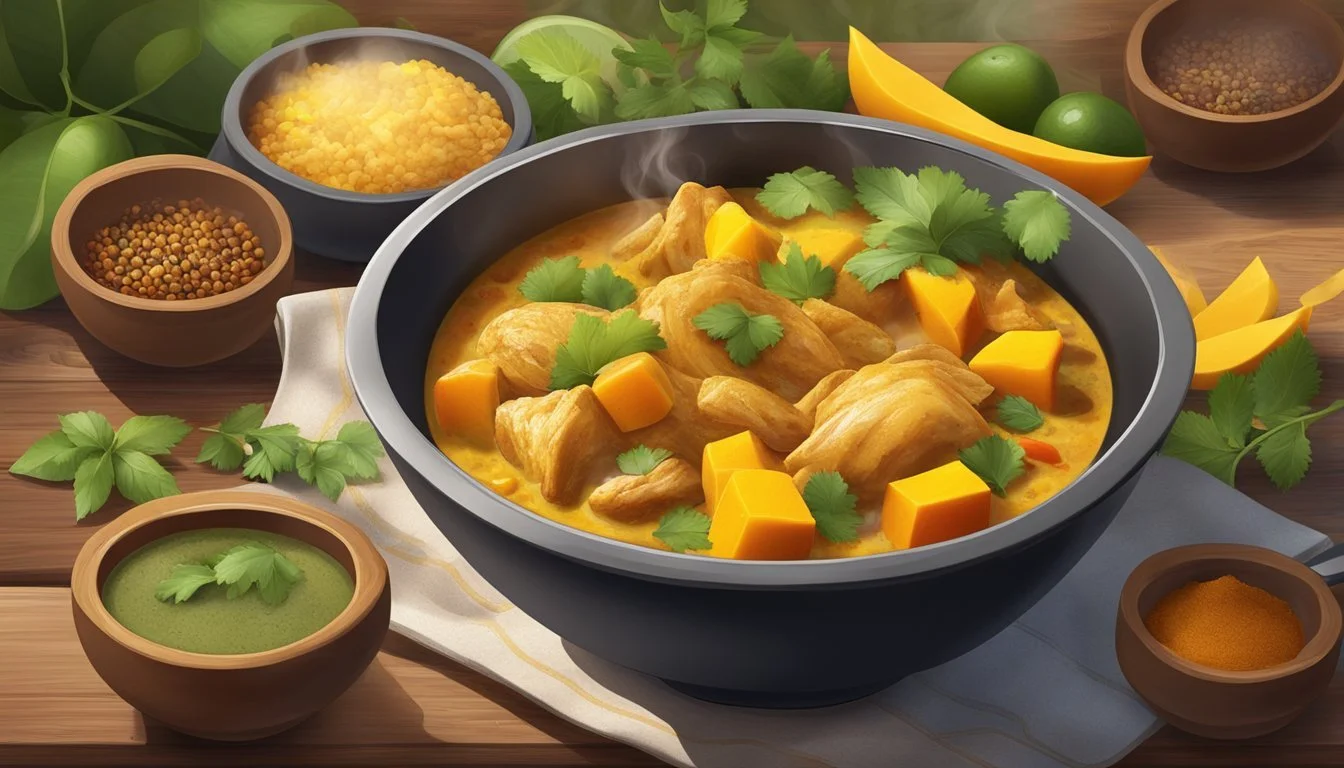Best Way to Reheat Mango Chicken Curry
Maintaining the Perfect Balance of Flavors
Mango chicken curry marries the velvety sweetness of mango with the complex spices typical of a savory curry. This delightful dish is a favorite for its balance of flavors but presents a challenge when it comes to reheating. Ensuring that the sweet and savory elements of the curry are preserved during reheating is crucial to enjoying the dish as it was intended to be savored.
Reheating mango chicken curry involves more than just bringing it back to a suitable temperature. The process must be carefully managed to maintain the dish's delicate flavors and prevent the chicken from drying out. Understanding the best methods to reheat this dish can make the difference between a just-okay meal and a culinary delight that replicates the taste of freshly made curry.
Understanding Mango Chicken Curry
Mango Chicken Curry integrates the richness of curry spices with the natural sweetness of mangos, resulting in a dish that delights with its perfect balance between savory and sweet notes. The ideal reheating method preserves these distinct flavors without compromising the curry's texture.
Defining the Dish
Mango Chicken Curry is a culinary creation that marries the bold flavors of a traditional chicken curry with the tropical sweetness of ripe mangos. It typically involves simmering succulent pieces of chicken in a myriad of spices and then enhancing the sauce with pureed or diced mangos. The addition of mangos lends a unique sweet profile that complements the aromatic spices often found in a curry.
Key Ingredients
Mango Chicken Curry is built upon a foundation of key ingredients that define its character:
Chicken: Usually cut into bite-sized pieces, which absorb the array of flavors.
Mangos: Either pureed or in chunks, these add a sweet contrast to the dish.
Curry Powder: A blend of spices such as turmeric, coriander, and cumin.
Coconut Milk: For creaminess and a mild flavor that balances the spice.
Salt and Pepper: Essential seasonings that amplify the other flavors.
Each component contributes to the complexity of the dish, creating a robust flavor profile that is both sweet and savory.
Preparation for Reheating
Before reheating mango chicken curry, ensure proper storage to maintain its flavors and safety. Preparation starts with how the curry is stored and the containers used for reheating.
Storage Best Practices
Storing mango chicken curry correctly is critical for preserving its quality. The curry should be cooled to room temperature before storage to prevent bacterial growth. Once cooled, it can be stored in the fridge for 2-3 days. For longer storage, the freezer is suitable for up to 3 months. Using an airtight container is essential to prevent contamination and odor absorption from other foods.
Fridge Storage:
Cool to room temperature within 2 hours of cooking.
Refrigerate promptly in an airtight container.
Consume within 2-3 days.
Freezer Storage:
Cool to room temperature.
Transfer to freezer-safe airtight containers or heavy-duty freezer bags.
Label with the date and freeze.
Thaw overnight in the fridge before reheating.
Selecting Containers
The choice of container for reheating affects the outcome of the curry. For oven or microwave reheating, glass or ceramic containers are advisable. If using a stovetop, a pan with a heavy bottom is ideal for even heating and preventing the curry from sticking or burning.
Oven/ Microwave:
Use microwave-safe or oven-proof glass or ceramic.
For ovens, cover with foil or a lid to prevent drying.
Stovetop:
Select a heavy-bottomed pan for even heat distribution.
A splash of water or stock can be added to adjust consistency.
Reheating Techniques
Proper reheating preserves the sweet and savory flavors of mango chicken curry. Each method offers advantages for restoring the dish to its original taste and warmth.
Stovetop Method
One reheats mango chicken curry on the stove by placing it in a pot over medium heat. They should stir occasionally and may add a small amount of water or chicken stock to maintain the curry's moisture.
Temperature: Medium
Tools: Pot, Spoon/Stirrer
Duration: 5-10 minutes
Oven Method
Using an oven to reheat involves preheating it to 350°F (180°C), transferring the curry into an oven-safe dish, and adding a bit of water. The dish should be covered with a lid or foil to retain moisture.
Temperature: 350°F (180°C)
Tools: Oven-safe dish, Foil/Lid
Duration: 15-20 minutes
Microwave Method
The microwave offers a quick reheating option. The curry should be placed in a microwave-safe dish, covered loosely, and heated on high. Stirring every minute ensures even heating and prevents hotspots.
Temperature: High setting
Tools: Microwave-safe dish, Plastic wrap
Duration: 2-3 minutes per serving
Alternative Reheating Methods
Reheating in an air fryer or under the broiler are less common but viable options for reheating mango chicken curry. Both methods should be monitored closely to prevent drying out or burning the curry.
Air Fryer: Set at a moderate temperature, and briefly reheat the curry until warm.
Broiler: Watch closely as the high heat can quickly overcook the curry.
Retaining Texture and Flavor
When reheating mango chicken curry, maintaining the integrity of the curry's texture and flavor is paramount. One must skillfully manage the heating process, incorporate moisture, and adjust the seasonings to preserve the dish's delicate balance.
Managing Heat and Time
Careful temperature control is crucial; too much heat can deteriorate the texture of the chicken and mango pieces. Reheat the curry over medium heat on the stove, stirring occasionally. This method should take about 5-10 minutes, ensuring that the chicken heats evenly without overcooking. The goal is to reach a safe internal temperature without compromising the curry’s texture.
Adding Moisture During Reheating
The curry may thicken when stored in the refrigerator. To restore its consistency and prevent dryness, add a bit of liquid. Options include:
Water: a splash can help thin the sauce.
Stock: a few tablespoons can enhance the flavor.
Butter or oil: a small amount can improve the curry's richness.
Adding these incrementally will let one gauge the curry's consistency as it gently reheats.
Adjusting Seasonings Post-Reheating
After reheating, taste the curry and fine-tune the seasonings, if necessary. As flavors might have mellowed in storage:
Salt and pepper: Adjust to taste.
Lime juice: A squeeze can brighten the flavors.
The addition of fresh seasonings after reheating can revitalise the curry's aromatic profile, especially if the storage has muted the flavors.
Safety Considerations
When reheating mango chicken curry, one must prioritize food safety to prevent illness. Ensuring the curry is reheated to the proper temperature mitigates bacterial growth and maintains the dish's quality.
Preventing Bacterial Growth
Mango chicken curry should be stored in the refrigerator within two hours of cooking to prevent bacteria from establishing a foothold. Bacteria thrive between 40°F (4°C) and 140°F (60°C), a range referred to as the "danger zone." It's crucial to reheat the curry quickly and evenly to pass through this temperature range and inhibit bacterial proliferation.
Refrigeration: Store curry at or below 40°F (4°C).
Reheating: Heat to 165°F (74°C) quickly to limit bacterial growth.
Stirring: Stir occasionally to ensure even heating.
Checking Internal Temperature
A reliable way to ensure safety is by checking the internal temperature of the curry. Using a food thermometer, one should aim for at least 165°F (74°C) to guarantee that any potential bacteria are destroyed. Uneven heating might leave parts of the dish in the danger zone; hence, the mango chicken curry must be checked in several places.
Uniformity: Check the temperature in multiple spots.
Avoid rubbery texture: Overheating can make the chicken rubbery, monitor the temperature closely.
By applying these safety measures, one safeguards the health of those consuming the reheated mango chicken curry while preserving its sweet and savory attributes.
Serving Suggestions
When it comes to enjoying mango chicken curry, the choice of sides and garnishes is essential in creating a well-rounded meal that complements the sweet and savory notes of the dish.
Complementary Sides
Rice: A bed of fluffy basmati rice serves as the classic side, absorbing the rich sauce of the curry.
Cauliflower Rice: For a low-carb alternative, cauliflower rice offers a nutritious complement without compromising on taste.
Garnishing for Enhanced Flavor
Naan Bread: Warm naan bread, with its soft and pillowy texture, is perfect for scooping up curry and sauce.
Cilantro: A sprinkling of fresh cilantro can contribute a crisp herbal contrast to the sweetness of the mango chicken curry.
Dealing with Leftovers
When it comes to managing leftovers of mango chicken curry, understanding the ideal storage methods is critical to preserving its sweet and savory flavors.
Refrigeration Versus Freezing
Refrigeration is suitable for mango chicken curry expected to be consumed within 1-3 days. The curry should be stored in an airtight container to maintain its quality and prevent the absorption of other food aromas from the refrigerator.
Storage Method Duration Container Type Consideration Refrigeration 1-3 days Airtight Quick use Freezing Up to 3 months Airtight, freezer-safe Long-term storage
For those who wish to keep their mango chicken curry beyond a few days, freezing is the preferable option. In a freezer-safe, airtight container, mango chicken curry can be frozen for up to three months. This method helps to lock in flavors, although there might be slight texture changes when thawed.
Thawing and Reheating Frozen Curry
Thawing frozen mango chicken curry should ideally be done in the refrigerator, allowing it to defrost slowly and safely. It usually takes anywhere from 12 to 24 hours for curry to thaw completely in the refrigerator, depending on the quantity.
Once thawed, the curry should be reheated gently to avoid overcooking the chicken and to preserve the delicate balance of sweet and savory flavors from the mango and spices. Reheating can be done on the stovetop, over medium heat, while stirring frequently, for about 5-10 minutes or until thoroughly heated through. If one opts for reheating in the oven, it should be covered and placed in a preheated oven at 350°F (175°C) for about 20 minutes, stirring once halfway through the heating process.
Diverse Curry Variations
When exploring the rich tapestry of curry dishes, one quickly finds that variations are plentiful and tailored to a broad array of tastes. From the sea's bounty to the earth's harvest, every type of curry offers a distinctive flavor profile and ingredient matrix.
Prawn and Fish Curries
Prawn curries often embrace the crustacean's delicate texture and sweetness, shining with spices that complement, not overwhelm. They are typically simmered in a sauce made aromatic with a balance of turmeric, cumin, and sometimes coconut milk for creaminess. On the other hand, fish curries involve careful cooking to retain the fish's integrity, utilizing acidity, such as tamarind or tomatoes, to enhance the flavor while a low simmering heat prevents the fish from flaking apart. For example, a regional specialty may slow-cook fish in a curry sauce thickened with ground coconut and spiced with green chilies.
Vegetable and Lamb Curries
Vegetable curries can vary considerably, from dry sautés to soupy stews, each celebrating the main ingredient, be it eggplant, potato, or mixed vegetables. They often incorporate a masala of cumin, coriander, and garam masala, providing warmth and depth. Lamb curries, sought after for their rich, gamey taste, are usually prepared with a robust sauce. Tender pieces of lamb are stewed with a hearty mix of spices like cardamom, cloves, and cinnamon, often until the meat is succulent and the flavors marry well, characteristic of dishes such as the slow-cooked Rogan Josh.







